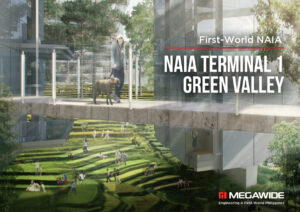-
The Megawide-GMR consortium has submitted the last additional requirements for its P109-billion proposal to rehabilitate and transform Ninoy Aquino International Airport
-
Additional documents include the consortium’s statement of joint solidary liability required by the National Economic Development Authority
-
Megawide hopes the proposal can now be elevated to the Cabinet Committee for approval and can proceed to the Swiss challenge

The consortium of Megawide Construction Corp. and India-based GMR Infrastructure Ltd. has submitted the last additional requirements for its P109-billion unsolicited proposal to rehabilitate and transform Ninoy Aquino International Airport (NAIA).
READ: Megawide to submit final requirement for P109B NAIA contract this week
The additional documents, submitted to Manila International Airport Authority (MIAA), include the consortium’s statement of joint solidary liability as required by the National Economic Development Authority (NEDA), Megawide said in a statement.
“The financial documents we submitted are sufficient to exclusively support the requirements of the NAIA project,” Megawide managing director for transport Louie Ferrer said. “With this, we are hopeful our proposal to rehabilitate and transform NAIA into a first-world airport complex can now be elevated to the Cabinet Committee for approval and proceed to Swiss challenge.”
The consortium had submitted the unsolicited proposal in 2018 and was granted the original proponent status (OPS) last July after the government terminated negotiations with NAIA Consortium, which had also proposed to rehabilitate the country’s main gateway.
However, last August, the Department of Transportation (DOTr) said the consortium still needed to address issues on its financial capacity and joint liability for the project to proceed.
The NEDA-Investment Coordination Committee (ICC) also noted a number of pending compliance with certain requirements of the Build-Operate-Transfer Law.
READ: NAIA project pending Megawide-GMR compliance with BOT Law
Last November 11, Megawide said GMR agreed to have a 40% equity participation in the project. Megawide said this will ensure “solid financial capability and delivering unparalleled global experience in airport design, construction and operations.”
READ: GMR still part of NAIA rehab project, says Megawide
“Our partnership with GMR is strong. Together, we delivered the transformation of Mactan-Cebu International Airport (MCIA) and the construction of Clark International Airport (CIA),” Megawide chairman and chief executive officer Edgar Saavedra said.
“Now, we are hugely excited to deliver a first-world NAIA that uplifts the travel experience for all Filipinos and provides a critical assist to the national government’s efforts to rebuild after the pandemic.”
The tandem of Megawide-GMR, through GMR-Megawide Cebu Airport Corporation, won a 25-year concession in 2014 to manage and develop MCIA. It also won in 2017 the contract to engineer, procure, and construct the CIA expansion project.
If approved by the NEDA-ICC and then the NEDA Board, the unsolicited proposal for NAIA’s rehabilitation will undergo a Swiss challenge wherein other interested parties can make counter proposals, which the consortium, as the original proponent, can then match.
Megawide earlier said it is hoping that project bidding will be finished by the first quarter of 2021.
Benefits to redound to passengers
In a separate statement, Megawide said that if their consortium is awarded the project, “the Filipino public will experience reduced queuing times and shortened delays at all terminals, clean and improved restrooms, expanded shopping and dining, plus enhanced and smoother security, baggage handling and more.”
The tandem is proposing to increase NAIA’s current capacity of 30 million to 65 million passengers per annum through a strategic and phased approach.
NAIA’s Terminals 1 to 3 are expected to see massive improvements, particularly in the first phases of the concession, Megawide said. This will allow passengers efficient use of facilities and faster transactions, while they can also enjoy their stay in the terminals with better dining and retail experience.
According to the plan, the 40-year-old Terminal 1 will be rehabilitated and expanded and check-in areas will be reconfigured.
The existing structure, designed by National Artist Leandro Locsin, will be retained and enhanced, but the open parking area and back parking building will be redesigned and integrated into the Terminal 1 complex.
Megawide said the centerpiece is envisioned to be a fully sustainable micro-climate “Green Valley” inspired by the Banaue Rice Terraces.
At Terminal 2, reconfiguration of check-in, expansion of dining and retail areas, and improvements in the baggage handling system will be made. Canopies will be installed in the parking facility open areas to allow people to move seamlessly, and the drainage system will be fixed to prevent flooding.
At Terminal 3, new pedestrian canopies will also be installed, while enhanced security areas and bathroom renovations will be prioritized.
Airside, the consortium will construct an additional taxiway and include runway holding areas to allow planes to queue and depart as soon as the runway becomes available, thus making air traffic significantly manageable.
In the coming years, Phases 2 and 3 will be dedicated to relocating and replicating the existing facilities, developing a brand-new international terminal, enhancing all parking, and introducing a railway-based people-mover system, akin to other major global airports.





